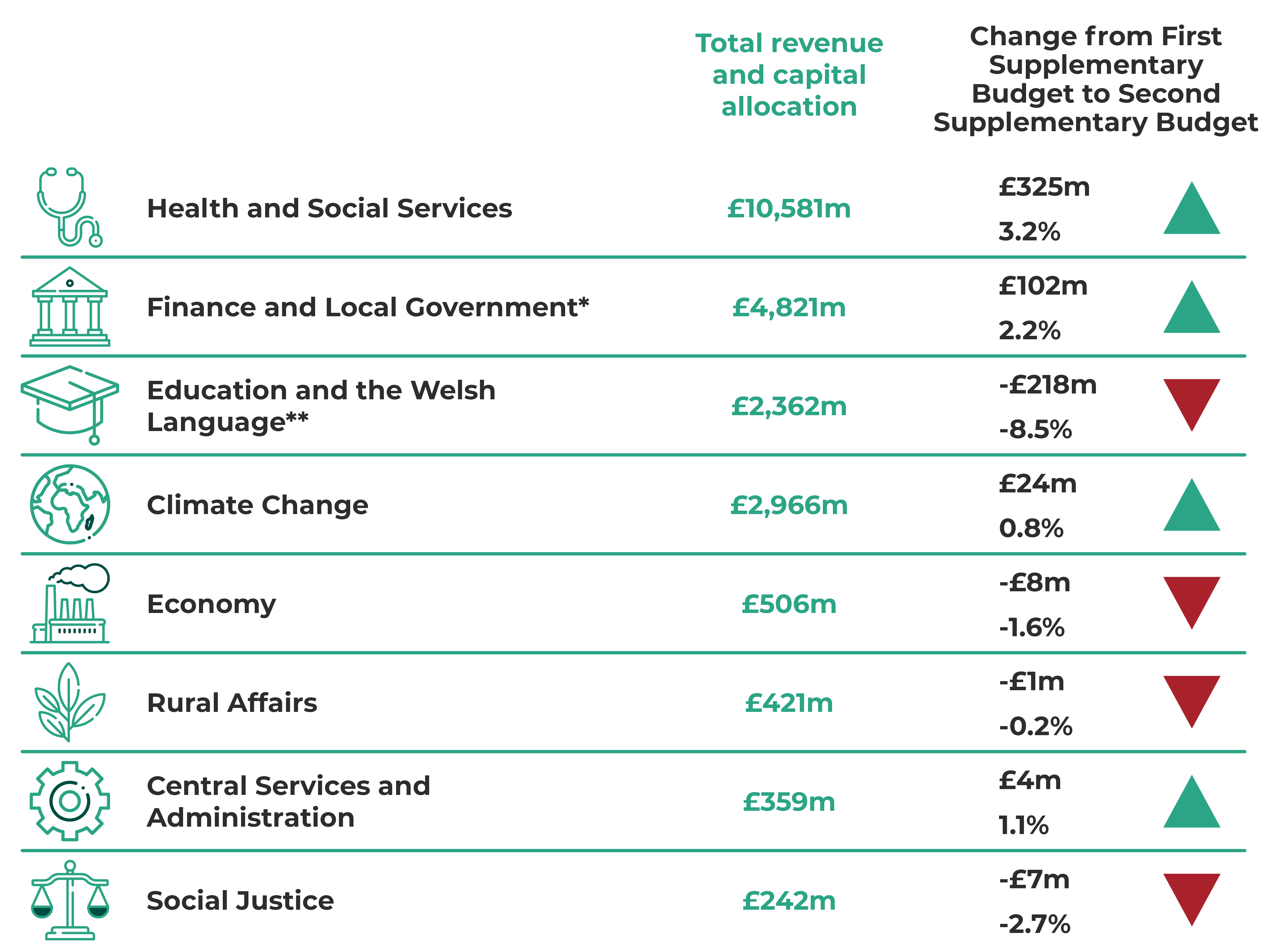The Welsh Government published its Draft Budget for 2022-23 in December 2021, unaware of some of the challenges it would end up facing this year. These include supporting those seeking sanctuary from Ukraine, double digit inflation and the rising cost of living.
How is the Welsh Government using its resources to respond to those challenges? On 14 February 2023, it published its Second Supplementary Budget for 2022-23, setting out the changes since the First Supplementary Budget in June 2022. This article summarises the financing and allocations in what’s likely to be the Welsh Government’s last budget for this financial year.
The last budget for 2022-23?
In its supplementary budgets, the Welsh Government sets out in-year changes to its allocations. This follows publication of the draft and final budgets before the start of the financial year.
The First Supplementary Budget 2022-23 set out the changes to the Final Budget (published in March 2022). We summarised the key allocations, as well as the funding available and how much the Welsh Government had left to spend, in our article ‘The Welsh Government’s First Supplementary Budget 2022-23’. The Senedd approved the First Supplementary Budget on 12 July 2022.
Fast forward eight months and the Welsh Government published its Second Supplementary Budget 2022-23 in mid-February, a little over six weeks before the end of the financial year. This is probably the Welsh Government’s last chance to make any changes to its budget allocations for 2022-23.
The Welsh budget decreases by over £900m but most relates to non-cash allocations
The Welsh Government notes adjustments – both increases and decreases – to its allocations from the UK Government. These include changes to the funding available but they also involve adjustments to the non-cash (known as ‘non-fiscal’) allocations.
Non-cash allocations generally relate to technical issues, such as a reduction in the value of the Welsh Government’s assets. These assets include Student Loans, and the Welsh Government says its budget for these alone decreases by £580.2m. Added to this is an adjustment to the Welsh budget for Student Loans programmes that are demand-led (known as ‘Annually Managed Expenditure’ or ‘AME’ budgets). This budget decreases by £496.5m, reflecting the forecasts the Welsh Government gave in January 2023 to HM Treasury.
These decreases are partially offset by increases in devolved tax income, with an additional £14.2m expected from Land Transaction Tax and £8.3m from Landfill Disposals Tax. The Welsh Government does not propose any changes to its borrowing plans, which remain at £150m for 2022-23.
The Welsh Government is planning to draw down an additional £141m, comprising £91m for revenue and £50m for capital, from the Wales Reserve; the funds it is able to carry forward from one financial year to another, subject to limits agreed by the Welsh and UK Governments.
It is also transferring sums to and from its unallocated reserves, funding a net £223.7m from its reserves to its departments and other bodies funded directly from the Welsh Consolidated Fund.
As a result of the changes to its funding and the Welsh Government’s financing decisions, the Welsh Budget decreases by £934.1m, compared with the First Supplementary Budget.
The Welsh Government’s unallocated reserves fall to £421.5m from almost £1bn after the First Supplementary Budget. Within this, its funding available for day-to-day spending is only £1.5m.
Half of Welsh Government departments see a decrease in funding
There are only marginal changes to the amount allocated to Welsh Government departments for discretionary areas of spending. Overall, this increases by £221m or 1%, compared with the First Supplementary Budget 2022-23. It’s worth noting the Welsh Government has restated figures relating to the First Supplementary Budget to reflect changes in Ministerial responsibilities.
Half of the Welsh Government’s eight departments see an increase in their allocations, with the largest increase in absolute and percentage terms for Health and Social Services (£325m or 3.2% compared with the First Supplementary Budget). The largest decrease is for Education and the Welsh Language (a decrease of £218m or 8.5%, compared with the First Supplementary Budget).

DEL is the discretionary part of the budget that the Welsh Government chooses how to spend.
AME is the non-discretionary part of the budget.

* Excludes around £1,030 million non-domestic rates income.
** Includes allocation of £208 million of non-fiscal revenue due to student loans.
Figures are rounded. Refer to the Welsh Government Second Supplementary Budget 2022-23 for exact figures.
Along with the reduction to its non-cash budgets, the Welsh Government identifies three “key allocations” it makes from its unallocated reserves in its Second Supplementary Budget.
An extra £91.7m has been allocated to support people arriving from Ukraine
The Welsh Government allocates an extra £91.7m to support those fleeing the conflict in Ukraine. The UK Government has provided £74.4m of this and the Welsh Government allocates the remainder from its reserves. This brings the total allocated by the Welsh Government in 2022-23 to £112m. It says the funding is being used to provide a range of support, including continuing to “fund a national contact centre, helpline and arrival hubs”.
Inflation will impact on all of the public sector, but extra funding is allocated for NHS energy costs only
Despite the Minister for Finance and Local Government acknowledging its impact will be felt “right across Welsh Government, and beyond”, additional funding to tackle inflation is made to the NHS only, with £81m allocated for “exceptional energy costs”.
The Welsh Government’s additional support for the Health Service in Wales also includes £89m to support the “additional ongoing costs related to [its] Covid-19 response still faced by NHS organisations”.
Public sector pay is a big challenge for the Welsh Government
The Minister identifies public sector pay as the Welsh Government’s biggest challenge relating to inflation.
The Welsh Government described the pay offers it made for NHS Wales staff and teachers as the “maximum” it can afford. Funding for these potential settlements has been found in this financial year, with an additional £120m allocated for NHS Wales Staff and £32m for teachers in the Second Supplementary Budget.
On 15 February 2023, the media reported that the National Education Union (NEU) had rejected the Welsh Government’s pay offer for 2022-23.
On 28 February 2023, the Welsh Government announced that Trade Unions, as the Wales Partnership Forum, had “narrowly accepted the enhanced pay offer” it had proposed for NHS Wales staff. However, soon afterwards the media reported that Members of the Royal College of Nursing (RCN) had voted "overwhelmingly to reject" the offer.
With the funding being time sensitive to 2022-23, on 1 March 2023 the Senedd Finance Committee asked the Minister what would happen if the pay offers were not accepted before the end of March 2023.
The Minister said the Welsh Government had “plans for either scenario”.
What’s next?
The Second Supplementary Budget 2022-23 will be debated in Plenary on 14 March, and available to watch live on Senedd TV.
Article by Joanne McCarthy and Joe Wilkes, Senedd Research, Welsh Parliament






